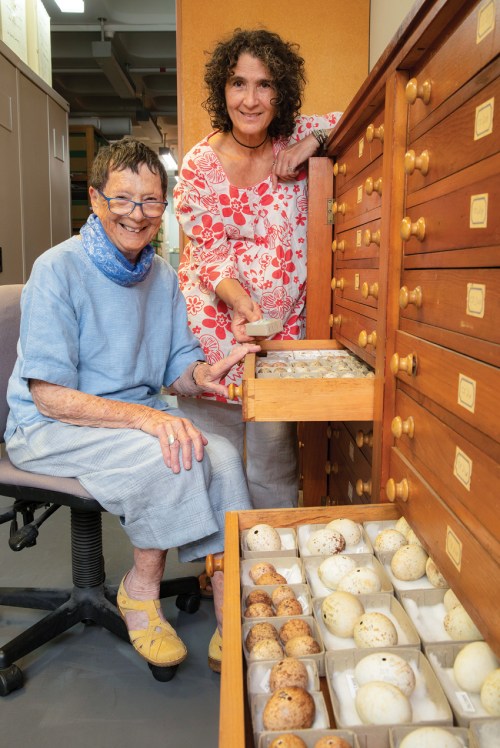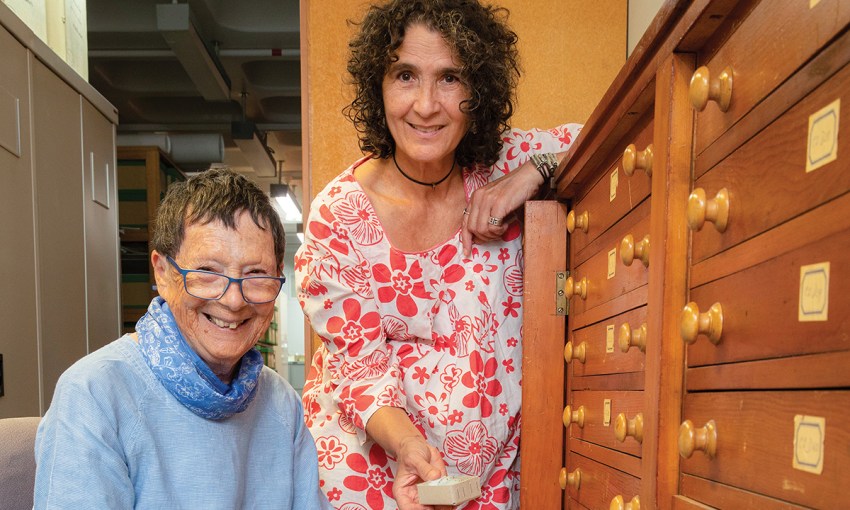A special mother-daughter collaboration has played out inside the storage rooms at the South Australian Museum, resulting in a remarkable book, documenting bird life – and loss – in Adelaide’s former Reedbeds.
Taking flight
In the early 1700s when German composer Johann Sebastian Bach began writing what would become enduring and much-loved orchestral music, he dipped his quill in iron gall ink to record his notes and cadences.
Many of his original manuscripts still survive today, stored in cultural institutions across Europe.
More than a century later – and on the other side of the world, in the colony of South Australia – conservationist and ornithologist Captain Samuel Albert White waded through a section of wetland known as the Reedbeds, just west of the colony’s newly established capital, Adelaide.
It was here that he spent years, from the late 1800s to the early 1900s, collecting and preserving birds’ eggs – from species some of which are now locally extinct – including those of the Azure Kingfisher, Regent Honeyeater and Ground Parrot.
As he catalogued the birdlife, he dipped his fountain pen in iron gall ink, to record his findings on scientific paper slips.
Many of Captain White’s original labels still survive today, stored inside the South Australian Museum, which preserves his significant egg and bird-skin collection, donated to the museum in 1988 by his wife.
What connects 18th century Bach with 19th century White is the ink they used, made from iron salts and the tannins of tree galls, and commonplace from the Magna Carta’s signing in 1215; ink that is now slowly deteriorating and corroding the paper on which the words and notes were written.
More than two centuries after Bach wrote his concertos and a century after Captain White documented the birds of the Reedbeds, Adelaide artist Jorji Gardener has become fascinated by iron gall ink.

She’s sitting in a climate-controlled room deep inside the SA Museum’s city storerooms, wearing white curatorial gloves, preparing to pick up and examine a selection of Captain White’s labels.
For the past four years, Jorji, as a museum volunteer, has been involved in a special project with professional conservators at Artlab, working to preserve and stabilise these deteriorating labels using transparent Japanese paper – a method used worldwide to preserve deteriorating historic documents written in iron gall ink.
“There is a great deal of science and years of study involved in learning the art of paper conservation and the opportunity for me to learn a tiny fraction of this specialised skill has been a unique and invaluable experience,” Jorji says.
What’s made this experience even more invaluable is that it has led to a special mother-daughter collaboration in the form of an art exhibition and book, called Flight (named not only in honour of the birds, but the fact that a section of the old Reedbeds is now the Adelaide Airport).
Jorji became so intrigued by the ink, that she began to make her own homemade concoctions using native galls (generally found where the Australian gall wasps laid eggs on acacias or Aleppo oaks) and used this ink to reproduce White’s labels and sketch the bird specimens in his collection, as an art project. “I wanted to document the birds of the White collection to highlight species loss, and I had wanted to do a collaboration with my mum for some time and this seemed like an ideal opportunity,” Jorji says.
Her mother, Viv Szekeres – former renowned director of the Migration Museum and book illustrator – began sitting beside her daughter in the SA Museum, sketching the birds, too.
But as Viv went on with drawing the dead birds, the sadder she became, to the point where she didn’t want to do it anymore. So, instead, she went away and began painting the birds – in watercolour – as she imagined they would look in the wild.
The result is a combined 90 artworks that were originally hung as an exhibition during 2022’s SALA Festival.

“It wasn’t until the exhibition was hung that we saw all the work together and it was very moving, but, also, we realised how important it was to have the dead, and the live birds, to contrast each other,” Jorji explains. “Because without Viv’s live birds, mine could be difficult viewing.”
Viv’s artworks have now been placed side-by-side with Jorji’s artworks in the book Flight, which also details the work of Captain White as well as Kaurna history of the Reedbeds and detailed analysis of the iron gall ink project. “It was very important to us that we acknowledged that the birds had names prior to colonisation. We spoke to Kaurna elder, Uncle Mickey Kumatpi Marrutya O’Brien, to get permission to include the Kaurna names in the book,” Jorji explains.
“We’re also highlighting the importance of what museums and conservators do, because without White’s collection we would never know the birds that existed in that area because so many of them are gone,” she says. “The other aspect, is our collaboration: mother and daughter. It’s been a really big highlight and, in fact, we both really miss it.”
But Jorji is still involved in the ink…it’s become the basis of her Adelaide Central School of Art honours thesis.
“What’s surprised me is how much I could fall in love with ink, although given I’m an artist, and the daughter of a historian, maybe it’s not so surprising,” she says.

“But I became fascinated with the stories that are held in these small, delicate, and often fragmented, strips of paper … they really hooked me; I’d be working on preserving the label, and put an artist/environmentalist in a science place and you’ll get a whole new view. I kept thinking: ‘This bird’s not here anymore’. The stories contained in those labels dragged me into this world and it went from there. I want people to know about these stories.”
The artwork of Flight is on display in the front foyer of the South Australian Museum throughout October for the Nature Festival.
This article first appeared in the September 2023 issue of SALIFE magazine.



